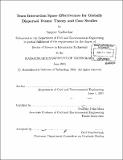| dc.contributor.advisor | Feniosky Peña-Mora. | en_US |
| dc.contributor.author | Vadhavkar, Sanjeev Sureshchandra | en_US |
| dc.contributor.other | Massachusetts Institute of Technology. Dept. of Civil and Environmental Engineering. | en_US |
| dc.date.accessioned | 2005-09-26T19:17:29Z | |
| dc.date.available | 2005-09-26T19:17:29Z | |
| dc.date.copyright | 2001 | en_US |
| dc.date.issued | 2001 | en_US |
| dc.identifier.uri | http://hdl.handle.net/1721.1/28235 | |
| dc.description | Thesis (Sc. D.)--Massachusetts Institute of Technology, Dept. of Civil and Environmental Engineering, 2001. | en_US |
| dc.description | Includes bibliographical references (leaves 261-275). | en_US |
| dc.description.abstract | Groups of geographically and/or organizationally dispersed members are increasingly being assembled to accomplish a wide range of organizational tasks using a combination of telecommunication and information technologies. The emergence of such technologically savvy globally dispersed teams has also heralded a complex and largely uninvestigated area of interaction practices of such team members. By enabling team interactions via non-traditional media, information technologies have actually expanded and transformed the conventional team interaction space. This merger of physical space with digital space has created a new kind of team interaction spaces, one where organizational, technological and spatial dimensions play significant roles. This research assesses the impact of team interaction space on perceived team performance using qualitative and quantitative research techniques. To collect qualitative data, interviews were conducted with 82' members from globally dispersed teams from three Global 500 companies. 45 audio, video and face-to-face team interactions between these team members were observed and analyzed. A survey on team interaction space was administered to the team members to substantiate the research hypotheses with quantitative data. Triangulating the qualitative and quantitative data, the research discovered significant correlation between the effectiveness of the team interaction space and perceived team performance. Factor, path and qualitative analysis demonstrated that organization protocols, communication technologies and spatial setup positively affect interaction space effectiveness. To explain the impact better, statistical evidence indicates that the impact of technology needs to be considered in multiple dimensions: ability, capability, reliability, accessibility and support. The research introduced team interaction space as a mediating variable to explain the role of technology, organizational processes and spatial setup on perceived team performance. The research also developed a team interaction space framework. | en_US |
| dc.description.statementofresponsibility | by Sanjeev Vadhavkar. | en_US |
| dc.format.extent | 275 leaves | en_US |
| dc.format.extent | 18332545 bytes | |
| dc.format.extent | 18369458 bytes | |
| dc.format.mimetype | application/pdf | |
| dc.format.mimetype | application/pdf | |
| dc.language.iso | en_US | |
| dc.publisher | Massachusetts Institute of Technology | en_US |
| dc.rights | M.I.T. theses are protected by copyright. They may be viewed from this source for any purpose, but reproduction or distribution in any format is prohibited without written permission. See provided URL for inquiries about permission. | en_US |
| dc.rights.uri | http://dspace.mit.edu/handle/1721.1/7582 | |
| dc.subject | Civil and Environmental Engineering. | en_US |
| dc.title | Team interaction space effectiveness for globally dispersed teams : theory and case studies | en_US |
| dc.type | Thesis | en_US |
| dc.description.degree | Sc.D. | en_US |
| dc.contributor.department | Massachusetts Institute of Technology. Department of Civil and Environmental Engineering | |
| dc.identifier.oclc | 49521952 | en_US |
